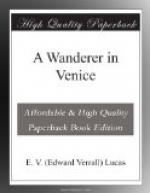Then the Rio Tron and then the Palazzo Battagia, with two rich coats of arms in relief, which is also by Longhena, but I hope that it was not he who placed the columns on the roof. The tiny Calle del Megio, and we reach the venerable piece of decay which once was the granary of the Venetian Republic—one of the most dignified and attractive buildings on the canal, with its old brick and coping of pointed arches. The Rio del Megio divides the granary from the old Fondaco dei Turchi, once, after a long and distinguished life as a palace, the head-quarters of the Turks in Venice, and now, admirably restored, the civic museum.
It is necessary to visit the collections preserved here, but I cannot promise any feelings of exultation among them. The Museo Civico might be so interesting and is so depressing. Baedeker is joyful over the “excellent illustrative guide (1909), 1 franc,” but though it may have existed in 1909 there is no longer any trace of it, nor could I obtain the reason why. Since none of the exhibits have descriptive labels (not even the pictures), and since the only custodians are apparently retired and utterly dejected gondoliers, the visitor’s spirits steadily fall.
One enters to some fine well-heads and other sculpture, not very different from the stock-in-trade of the ordinary dealer in antiquity who has filched a palace. On the next floor is a library; but I found the entrance barred. On the next is a series of rooms, the museum proper. In the first are weapons, banners, and so forth. In the second is a vast huddle of pictures, mostly bad copies, but patience may discover here and there an original by a good hand not at its best. I noticed a Tiepolo sketch that had much of his fine free way in it, and a few typical Longhis. For the rest one imagines that some very indifferent churches have been looted.
Follow four rooms of miscellaneous articles: weapons, ropes, a rather fascinating white leather suit in a case, and so forth. Then a room of coins and medals and ducats of the Doges right away from 1279. Then two rooms (VIII and IX) which are more human, containing costumes, laces, fans, the death masks of two Doges in their caps, a fine wooden balustrade from a fifteenth-century palace, a set of marionettes with all their strings, a Vivarini Madonna on an easel.
[Illustration: S. JOHN CHRYSOSTOM WITH SAINTS FROM THE PAINTING BY PIOMBO In the Church of S. Giov. Crisostomo]
Then some stairs and a set of eighteenth-century rooms with curiously real carnival costumes in them, like Longhi’s pictures come to life, and a painting or two by Guardi, including what purports to be his own portrait. Then a Chinese room, and a Goldoni room with first editions of the little man’s plays, his portrait, and other relics. This series undoubtedly brings Venice of the eighteenth-century very vividly before one.




